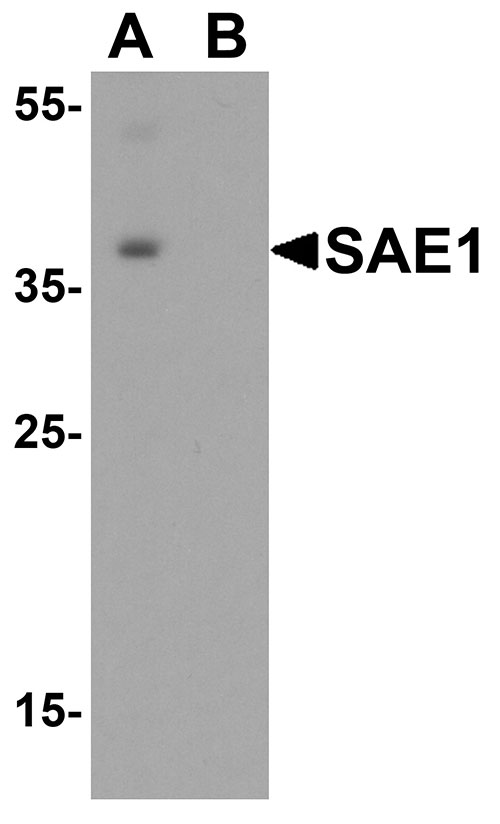SAE1 Antibody
- SPECIFICATION
- CITATIONS
- PROTOCOLS
- BACKGROUND

Application
| WB, E |
|---|---|
| Primary Accession | Q9UBE0 |
| Other Accession | NP_005491, 4885585 |
| Reactivity | Human, Mouse, Rat |
| Host | Rabbit |
| Clonality | Polyclonal |
| Isotype | IgG |
| Calculated MW | Predicted: 38 kDa Observed: 39 kDa |
| Application Notes | SAE1 antibody can be used for detection of SAE1 by Western blot at 1 µg/mL. |
| Gene ID | 10055 |
|---|---|
| Target/Specificity | SAE1; |
| Reconstitution & Storage | SAE1 antibody can be stored at 4℃ for three months and -20℃, stable for up to one year. As with all antibodies care should be taken to avoid repeated freeze thaw cycles. Antibodies should not be exposed to prolonged high temperatures. |
| Precautions | SAE1 Antibody is for research use only and not for use in diagnostic or therapeutic procedures. |
| Name | SAE1 |
|---|---|
| Synonyms | AOS1, SUA1, UBLE1A |
| Function | The heterodimer acts as an E1 ligase for SUMO1, SUMO2, SUMO3, and probably SUMO4. It mediates ATP-dependent activation of SUMO proteins followed by formation of a thioester bond between a SUMO protein and a conserved active site cysteine residue on UBA2/SAE2. |
| Cellular Location | Nucleus. |
| Tissue Location | Expression level increases during S phase and drops in G2 phase (at protein level). |

Thousands of laboratories across the world have published research that depended on the performance of antibodies from Abcepta to advance their research. Check out links to articles that cite our products in major peer-reviewed journals, organized by research category.
info@abcepta.com, and receive a free "I Love Antibodies" mug.
Provided below are standard protocols that you may find useful for product applications.
Background
SAE1 Antibody: Small ubiquitin-like modifiers (SUMOs) are a family of small, related proteins (SUMO-1/2/3/4) that can be enzymatically attached to a target protein by a post-translational modification process termed sumoylation, a major regulator of protein function in cellular processes such as nuclear transport, transcriptional regulation, apoptosis and protein stability. This sumoylation is effected by the heterodimeric enzyme SAE1/SAE2 and the SUMO-1-conjugating enzyme Ubch9. The sumoylation pathway mediated by SAE1/SAE2 is distinct from other ubiquitin-like protein (Ubl) pathways.
References
Kamitani T, Kito K, Nguyen HP, et al. Characterization of a second member of the sentrin family of ubiquitin-like proteins. J. Biol. Chem.1998;273:11349-53.
Kim KI, Baek SH, and Chung CH. Versatile protein tag, SUMO: its enzymology and biological function. J. Cell. Physiol.2002; 191: 257-68.
Desterro JM, Rodriguez MS, Kemp GD, et al. Identification of the enzyme required for activation of the small ubiquitin-like protein SUMO-1. J. Biol. Chem.1999; 274:10618-24.
Tatham MH, Jaffray E, Vaughan OA, et al. Polymeric chains of SUMO-2 and SUMO-3 are conjugated to protein substrates by SAE1/SAE2 and Ubc9. J. Biol. Chem.2001; 276:35368-74.
If you have used an Abcepta product and would like to share how it has performed, please click on the "Submit Review" button and provide the requested information. Our staff will examine and post your review and contact you if needed.
If you have any additional inquiries please email technical services at tech@abcepta.com.













 Foundational characteristics of cancer include proliferation, angiogenesis, migration, evasion of apoptosis, and cellular immortality. Find key markers for these cellular processes and antibodies to detect them.
Foundational characteristics of cancer include proliferation, angiogenesis, migration, evasion of apoptosis, and cellular immortality. Find key markers for these cellular processes and antibodies to detect them. The SUMOplot™ Analysis Program predicts and scores sumoylation sites in your protein. SUMOylation is a post-translational modification involved in various cellular processes, such as nuclear-cytosolic transport, transcriptional regulation, apoptosis, protein stability, response to stress, and progression through the cell cycle.
The SUMOplot™ Analysis Program predicts and scores sumoylation sites in your protein. SUMOylation is a post-translational modification involved in various cellular processes, such as nuclear-cytosolic transport, transcriptional regulation, apoptosis, protein stability, response to stress, and progression through the cell cycle. The Autophagy Receptor Motif Plotter predicts and scores autophagy receptor binding sites in your protein. Identifying proteins connected to this pathway is critical to understanding the role of autophagy in physiological as well as pathological processes such as development, differentiation, neurodegenerative diseases, stress, infection, and cancer.
The Autophagy Receptor Motif Plotter predicts and scores autophagy receptor binding sites in your protein. Identifying proteins connected to this pathway is critical to understanding the role of autophagy in physiological as well as pathological processes such as development, differentiation, neurodegenerative diseases, stress, infection, and cancer.


